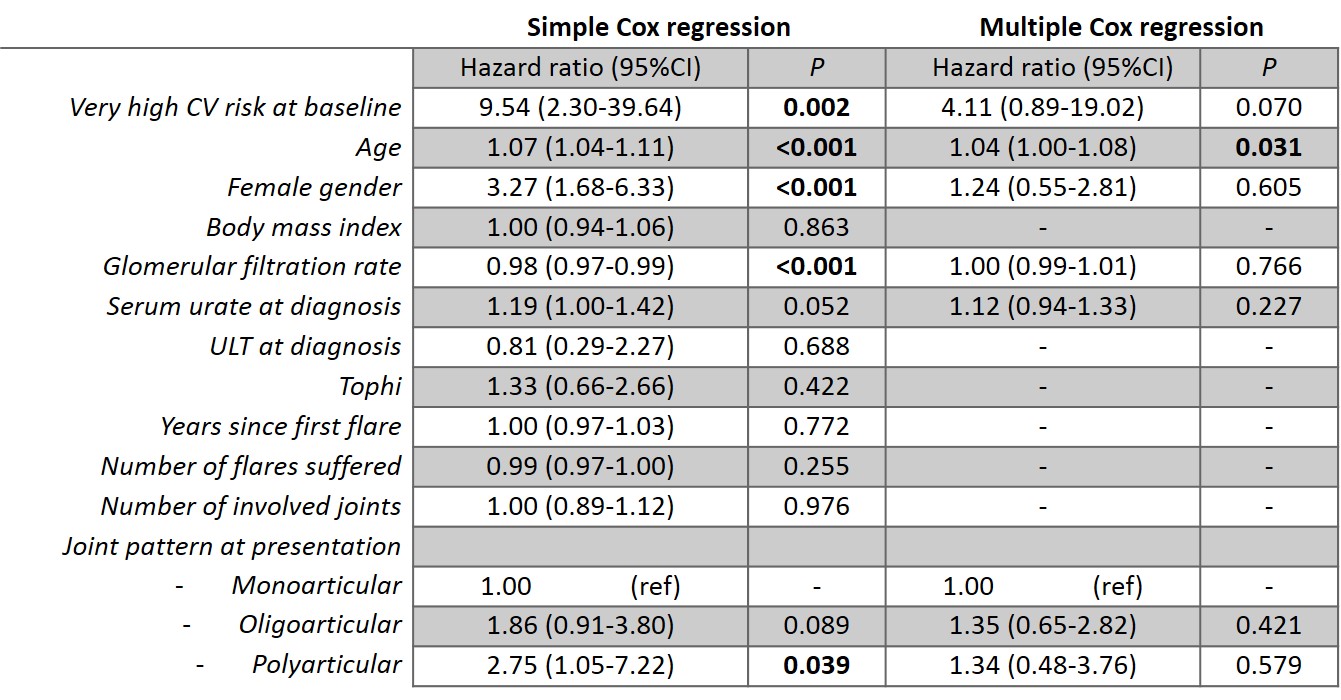Session Information
Session Type: Poster Session B
Session Time: 9:00AM-11:00AM
Background/Purpose: Gout is an independent cardiovascular (CV) risk factor. This excess of morbidity and mortality requires optimal management, especially in high-risk individuals. Therefore, the inclusion of subclinical atherosclerosis screening by carotid ultrasound in the initial evaluation may help to accurately stratify the CV risk. However, longitudinal outcomes using this approach are not available in gout. This study aimed to analyze the new CV events occurred in patients with gout after structured CV assessment incorporating carotid ultrasound.
Methods: Retrospective analysis of an inception cohort of patients with crystal-proven gout. At baseline, a structured CV assessment was performed considering age, gender, traditional risk factors, CV and renal disease, laboratory data, SCORE and Framingham risk tools, and carotid ultrasound; according to 2013 ESC guidelines, CV risk was stratified as low, moderate, high or very high. The cohort includes 356 patients, mean (SD) aged 64 years (14.0), mostly males (86.0%), 21.8% with tophaceous gout and mean serum urate at diagnosis of 8.2mg/dL (1.8). The CV risk stratification at baseline was low in 20 patients (5.6%), moderate in 47 (13.2%), high in 34 (9.6%), and very high in 242 (68.0%). Major CV events (coronary heart disease (CHD), heart failure (HF), stroke, peripheral artery disease (PAD) and CV death) were recorded during the follow-up by electronic case reports review. A binary composite endpoint of new major CV events was used. The incidence after inclusion in the cohort was estimated. To evaluate potential baseline predictors (clinical and gout-related) of CV events, a Cox regression model was built.
Results: Mean (SD) follow-up in the cohort was 41.5 months (16.8). Forty new major CV events have been identified (incidence 3.25 /100patient-year), distributed as follows: HF 1.46 (n=18), CV death 0.65 (n=8), CHD 0.49 (n=6), stroke 0.33 (n=4), and PAD 0.33 /100patient-year (n=4). Per risk stratification, the incidence of a new event was 0.16/ 100patient-year in the high-risk group and 3.01 /100patient-year in the very high-risk, while no events occurred in low and moderate groups. Noteworthy, five events occurring in the moderate (three) and high-risk (two) groups formed without considering carotid findings, were captured in the very-high risk group after the complete assessment.
The table shows the univariate and multivariate analysis of baseline predictors. An independent association and a trend towards significance were noted for age and to be classified at a very-high CV risk at baseline, respectively.
Conclusion: First longitudinal study assessing the use of subclinical atherosclerosis screening as part of CV risk assessment in new patients with gout. Those classified at the very high-risk group presented the majority of events, being HF the most frequent. Age, and likely being classified as very-high risk, independently predicted a new CV event during follow-up, data that may be of interest for the management of patients with gout at the time of diagnosis.
 Table. Analysis of baseline predictors of new cardiovascular events in the follow-up.
Table. Analysis of baseline predictors of new cardiovascular events in the follow-up.
To cite this abstract in AMA style:
Monzó M, Quilis N, Ranieri L, San-Martín A, Andrés M. Structured Cardiovascular Assessment in Gout Incorporating Carotid Ultrasound: Analysis of Subsequent Events in the Follow-Up [abstract]. Arthritis Rheumatol. 2020; 72 (suppl 10). https://acrabstracts.org/abstract/structured-cardiovascular-assessment-in-gout-incorporating-carotid-ultrasound-analysis-of-subsequent-events-in-the-follow-up/. Accessed .« Back to ACR Convergence 2020
ACR Meeting Abstracts - https://acrabstracts.org/abstract/structured-cardiovascular-assessment-in-gout-incorporating-carotid-ultrasound-analysis-of-subsequent-events-in-the-follow-up/
